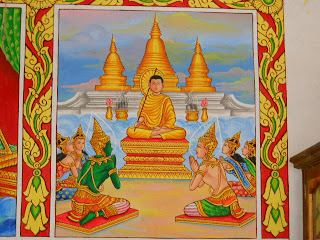 Stall at Tongkhankham market selling the prasat pheung which were decorated with chrysanthemum real flowers.
Stall at Tongkhankham market selling the prasat pheung which were decorated with chrysanthemum real flowers.During the recent temple festivals they were made of wax flowers and the base is from the banana trunk.
The design resembles that of a small palace.
Bank notes will be fixed onto the white thin sticks and after the ceremony will be donated by devotees to the temple.
Both Thai and Lao Buddhist culture are very similar.
Behind Tongkhankham market was a mainland Chinese owned Hua Long Hotel.
Quite a clean hotel and family owned and the room rates was 500,000 kips (about 110 renminbi acceptable payment).
A short distance from the hotel is Wat Tongkhankham.
The main entrance has an arch with statue of Buddha on top.
Laos National flag was in the centre flanked by two Buddhist flags.
Seated on the higher ground was the statue of Buddha shielded by a muiltiheaded serpent or Mucilinda,the naga king of a nearby lake that protected the Buddha from the torrential thunderstorm while Buddha was meditating under a tree.
Buddha attained enlightenment under the Bodhi tree.
Silently he vowed, "Even if my flesh and blood were to dry up, leaving only skin and bones, I will not leave this place until I find a way to end all sorrow."
He sat there for forty nine days. He was determined to discover the source of all pain and suffering in the world.
Mara, the evil one, tried to scare him into giving up his quest.
For instance, he hoped to lure Siddhartha into having selfish thoughts by sending visions of his very beautiful daughters.
But the Buddha's goodness protected him from such attacks.

Buddha's disciples, Sariputta, Maudgalyayana, Mahakasyapa, Ananda and Anuruddha are believed to have been the five closest to him.
This one is a bit related to Hinduism,most of the ladies seemed to have focus on a baby standing on a lotus.
She must be Lakshmi the Goddess of wealth and prosperity.
Lakshmi is the household goddess of most Hindu families, and a favorite of women.
She is being depicted as a beautiful woman of golden complexion, with four hands, sitting or standing on a full-bloomed lotus and holding a lotus bud, which stands for beauty, purity and fertility.
Her four hands represent the four ends of human life: dharma or righteousness, "kama" or desires, "artha" or wealth, and "moksha" or liberation from the cycle of birth and death.
Before dying, the Buddha gave his last sermon.
This last sermon had eight main points(8 fold noble path):
1) The more desires one has, the more they will suffer.
2) Be content with our state of being.
3) When the self and the external world become one, eternal serenity is enjoyed.
4) Without any interruption, practice meditation.
5) Do not forget what the Buddha taught.
6) Everything is constantly changing, including ourselves.
7) Nonattachment is the essential wisdom.
8) When we reach enlightenment we and the world become one, and there is no duality.
At the age of 29, Siddhartha began the homeless life of a monk.
From Kapilavatthu, he walked south to the city of Rajagaha, the capital of the Magadha country.
The king of this country was named Bimbisara.
This art has stories part of the Ramayana epics.
Looked like the people celebrating harvest time.
The inside view of the main temple hall.
A small Buddha Park sculptures being part of the landscape.
Sculptures of devotees kneeling holding silver bowl with gifts.
You'll noticed that there were many smaller shrines near the temple's wall perimeter which has the names of those who had died.
I presume their ashes must have been kept in the urn inside these shrines.

Two years ago I was here and this new site was still under construction.
Today the whole temple has been completed solely built by the monks themselves.

Soukrathsamy Center of English.












No comments:
Post a Comment